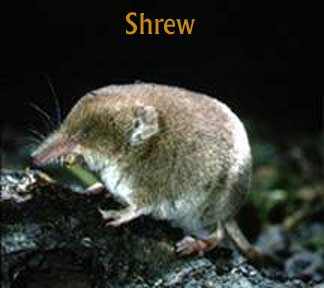

July 06, 2000
 Recently I have been criticized by a collector about my habit of calling the fetish usually known as a "mole" by the name of "shrew." I began doing this after reading that there were no moles in the desert southwest, and that the animal carved and known as a mole was most likely a shrew. I assumed -- as did the authors whose works I consulted -- that the Zuni people only carved the animals that inhabited their local environment. I also assumed that the misidentification occurred when white anthropologists (starting with Frank Cushing) had extended contact with the Zunis. My intent, in calling a mole a shrew...was to call the animal by its "rightful" name.
Recently I have been criticized by a collector about my habit of calling the fetish usually known as a "mole" by the name of "shrew." I began doing this after reading that there were no moles in the desert southwest, and that the animal carved and known as a mole was most likely a shrew. I assumed -- as did the authors whose works I consulted -- that the Zuni people only carved the animals that inhabited their local environment. I also assumed that the misidentification occurred when white anthropologists (starting with Frank Cushing) had extended contact with the Zunis. My intent, in calling a mole a shrew...was to call the animal by its "rightful" name.
It is true, there are no moles in the desert, because the ground is too hard and dry for them to burrow in. Moles like moist, leaf-laden composting-type soil. They eat earthworms and insect larvae that are found in this rich type of humus. Of the twelve genera of moles, five are found in the U.S. They range in size from .8 to 9.4 inches long. However, moles are indigenous to Europe, Asia, and North America.
And it is true that the animal found in Zuni-land is a shrew. Shrews are more mouse-like in body, but are related to the mole. They both have long, pointed snouts and soft gray-to-brown velvety fur. Most shrews live on the ground, though some are semi-aquatic or arboreal. They are very active, nocturnal animals who live on insects and worms but who will also eat mice equal their size, plants, and even fish. Shrews are found on all major land areas except the polar regions, Australia, New Zealand, Greenland, and Tasmania. Shrews in the U.S. range in size from less than 3" to nearly 5" in length.
My error in judgement came when I assumed that the ancestral Zunis carved only the animals in their local environment. It never occurred to me that they also carved buffalo...which did not venture as far south as Zuni. Steve Albert, Director of Zuni Fish & Game, says, "This is true - there are no moles in Arizona or New Mexico, though the eastern mole lives in Texas, not too far from New Mexico. Shrews do look like moles (somewhat) and there are several species of shrews in the Zuni area. Shrews have elongated noses, tiny eyes and big claws like moles do. However, just because there are no moles here in Zuni doesn't necessarily mean that they are not important animals (the bison would be another example)."
Steve soon followed that information with this update: "The animal carved and revered is indeed the mole. Despite the fact that there are no moles in Zuni, the animal represents the earth. One man told me that similarily, the polar bear is found nowhere near here, but is a sacred animal."
Dr. Allan Barnitt of the Department of Natural Sciences of Assumption College in Worcester, MA, also had these thoughts: "There are no moles in the Southwest. It's too dry. Moles like moist, soft earth with lots of earthworms and insects. Shrews have about 300 species and there are a couple of shrews in Arizona and New Mexico. One is the Desert Shrew, Notiosorex crawfordi. The animal that the Zunis carve, I believe, is a mole. A good example is Georgiann Quandelacy's moles. Moles are larger with shorter tails and no discernable neck. Shrews have longer tails and are smaller. Even though there are no moles in the area, they are carving moles. Perhaps, the mole in their culture predates their arrival in the desert. The oral history of the Zuni may include tales of moles carried over from their original homeland: Northwest U.S. or even Japan, if in fact, they migrated from Japan 800 years ago."
So, I stand corrected. Looks like all those critters are moles. It was narrow-minded of me to think that the Zunis would only consider the animals in their local environment sacred and important. Considering that their priests pray every morning at sunrise for all people and all animals on the planet...I should have known better!
Thanks to the collector who sparked this debate, to Steve Albert and Dr. Allan Barnitt for helping to answer my questions, and to the Zuni people, who are making all of us aware of our connections to each other and to the animals of this planet.
|



